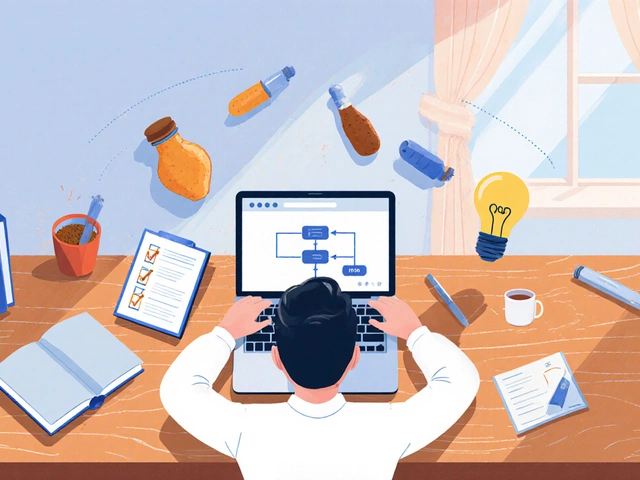
So, you're itching to switch to a teaching career but don't want to spend years getting there. Don't worry; you're not alone. Many people are eager to jump into classrooms quickly, and there are programs designed just for that.
One of the quickest ways to start teaching is through alternative certification programs. These are perfect if you already hold a bachelor's degree in another field but want to transition into teaching. They focus on equipping you with the necessary skills fast and effectively. You'll get some classroom time while you learn, making it a win-win.
Then there are online programs, which are a blessing if you need flexibility. Whether it's balancing a day job or managing a family, online credentials can fit into your schedule and speed things up. Plus, the support network of fellow students and instructors online can be surprisingly robust.
- Alternative Certification Programs
- Online Teaching Credentials
- Utilizing Prior Experience
- Tips for a Fast-Track Teaching Career
Alternative Certification Programs
So, let’s talk about alternative certification programs. These are a blessing for folks who already have a bachelor's degree in something like business or art and suddenly find themselves wanting to teach. It’s a fast track because you don’t need to go back and redo a four-year education degree.
In fact, you can get into these programs and be teaching in a classroom within a year in some cases. That’s right, one year! Such programs focus on the meat and potatoes of teaching - classroom management, lesson planning, and educational psychology - all the stuff you need to start teaching effectively.
How Do These Programs Work?
You might be wondering how these programs actually work. Basically, you complete a condensed version of teacher education courses, and they typically involve a period of supervised teaching, sometimes referred to as a practicum.
- Apply: Check the requirements in your state because they can vary. Most need you to pass some basic tests and have a bachelor's degree.
- Study: Dive into the courses. They're designed to be completed quickly while teaching practical skills.
- Teach: Many programs have arrangements with local schools so you can get real classroom experience.
Popular Programs to Consider
Lots of schools offer these speedy routes. For example, Teach For America places high-achieving college graduates in teaching positions in under-resourced schools. There’s also the American Board’s certification which is recognized in multiple states and focuses on a streamlined path to teaching.
If you want to go online, some universities offer completely digital certification courses. These are great if you're into learning at your own pace. Plus, many of these online options allow you to continue working your current job while you get qualified to teach.
Bottom line, if you’re looking to jump into teaching without a long detour back to college, alternative certification programs are the way to go. Just be sure to do your homework and pick the one that fits your timeline and goals.
Online Teaching Credentials
Opting for an online teaching credential program is a fantastic way to enter the teaching field without putting your life on hold. These programs are designed to be flexible and efficient, catering especially to those who need to balance other commitments. The days of having to attend night classes in a brick-and-mortar building are behind us!
One of the biggest perks of online programs is their self-paced nature. You can adjust the speed of your learning to match your lifestyle, which means if you've got the time and motivation, you might be able to finish faster than in a traditional setting. Plenty of these programs offer comprehensive coursework that prepares you for both theoretical and practical teaching aspects.
Top Features of Online Programs
- Accessibility: You can learn from anywhere with a reliable internet connection.
- Variety of Courses: Whether you want to teach math, science, or English, there's a program tailored for you.
- Mentor Support: Most platforms provide mentors who guide you through your teaching journey.
- Practicum Experience: Even online programs require real classroom practice, often at a nearby school.
Choosing the Right Online Program
Don’t just pick the first program you find. Look for ones accredited by recognized educational bodies. Accreditation ensures that the program meets certain standards and that your certification is valid nation-wide. Check reviews from past students and see if the curriculum aligns with your career goals.
| Program | Completion Time | Cost* |
|---|---|---|
| Teach for America Online Program | 6-12 months | $6,000 |
| American Board's Accelerated Certification | 10 months | $1,900 |
*Costs are approximate and can vary based on additional materials or state-specific requirements.
In terms of return on investment, these online programs can save you money compared to full-time university tuition. As soon as you get certified, you’re on your way to transforming lives in the classroom. Isn’t that just awesome?

Utilizing Prior Experience
Switching to teaching doesn't mean you start from scratch. Your previous work experiences can be a goldmine of skills that are totally transferable to the classroom. Understanding how to highlight these can get you on the fast track to a teaching credential.
Leverage What You've Got
Skills such as communication, teamwork, and leadership are essential in teaching. If you've been in a role that demanded these, you're already halfway there! For example, if you've ever led projects, that's akin to managing a classroom. Strong organizational skills? Teachers need those in spades for planning lessons and juggling different activities.
For those coming from specific fields, consider teaching related subjects. Worked in finance? Math classes could use your expertise. From the healthcare sector? Science education needs knowledgeable instructors. In many cases, schools value real-world experience that brings learning to life for students.
Certification Based on Experience
Some states offer alternative certification routes specifically designed for individuals with professional backgrounds. These often include shorter teaching certificate programs that capitalize on your work history. It's worth checking out your state's Education Department website for guidelines and options.
Here's a simple breakdown of experience translation:
| Job Role | Teaching Skill |
|---|---|
| Project Manager | Lesson Planning, Classroom Management |
| Sales Executive | Public Speaking, Persuasive Communication |
| Engineer | Problem Solving, Math & Science Instruction |
Practical Steps
- Make a list of skills and achievements from your previous jobs that align with teaching.
- Talk to current teachers about how these skills play out in a classroom setting.
- Consider enrolling in a fast-track program that values your professional background.
Breaking into teaching might seem daunting, but recognizing and utilizing your past experiences can make the transition smoother and quicker.
Tips for a Fast-Track Teaching Career
So, you've decided to jumpstart your teaching career, and you're ready to get going as fast as possible. Let's dive into some smart tips that will help you reach your goal quickly and efficiently.
1. Leverage Existing Degrees
If you already have a bachelor's degree, take advantage of it by enrolling in alternative certification programs. These programs are designed for degree holders in non-education fields to become teachers in about a year. They're practical, focused, and provide classroom experience.
2. Select an Accelerated Program
Look for schools that offer accelerated teaching credentials. Some programs promise completion in just 6-9 months. Be sure they're accredited and meet state requirements so you can start teaching immediately after finishing.
3. Consider Online Options
Can't commit to full-time classes? Online programs might be your best bet. They offer flexibility so you can learn while working. And they're just as comprehensive and respected as in-person programs.
4. Gain Classroom Experience Early
Start volunteering or working as a teaching assistant while you complete your coursework. This not only gives you a feel for the classroom but also strengthens your resume and networks with schools.
5. Stay Updated
Education is always evolving. Subscribe to education blogs, join forums, and follow teaching influencers. This constant learning will keep you ahead of the curve and help you bring fresh methods to your future classroom.
6. Utilize Financial Aids and Scholarships
Fast-tracking doesn't mean breaking the bank. Look into scholarships, grants, and loan forgiveness programs aimed at aspiring teachers. Financial aid can relieve some of the burden, letting you focus on becoming the best educator possible.
Take these tips to heart, and you'll be on your way to an educational career faster than you think. The key is to be proactive, informed, and flexible with your journey.







